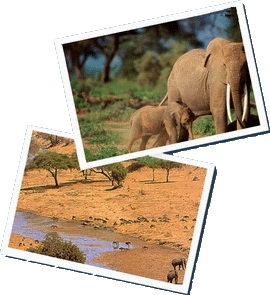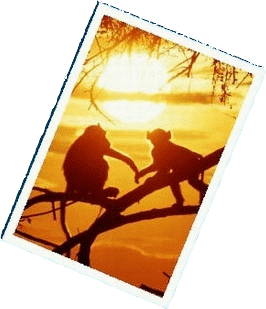|
|
|
| |
The Ngorongoro Crater, at 2,286m.above sea level, is the largest unbroken caldera in the world. Surrounded by very steep walls rising 610metres from the crater floor, this natural amphitheatre covers an area of about 260sq km that's 100sq miles-and is home to up to 30,000animals,almost half of them zebra and wildebeest.
There are also gazelle, buffalo, eland, hartebeest and wart hog.Such vast numbers attract predators a plenty, mainly lion and hyena but also cheetah and leopard. More than n 100 species of birds not found in the Serengeti have been spotted here. Countless flamingos form a pink blanket over the soda lakes.
The crater has been declared a World Heritage Site. The Ngorongoro Crater lies within the Ngorongoro Conservation Area, which covers more than 8,000sq km. It is bounded by Lake Eyasi in the southwest and the Gol Mountains in the north. Roughly in the centre is the Olbalal Swamp and the arid Olduvai Gorge.
Located within the Ngorongoro Conservation Area is the Olduvai Gorge, 180 kilometres from Arusha. It was here that Dr Louis Leakey discovered the remains of Homo habilis or “Handy man” regarded as mankind's first step on the ladder of human evolution. But many more fossils have been discovered here including those of prehistoric elephants, giant horned sheep and operate lecture tours of the sites.
|
|

|
| |
Close to Arusha, 118km away, Tarangire National Park gets its name from the river that threads its way through the length of the reserve. It is famous for its dense wildlife population, which is most spectacular between June and September, the dry period.
During this time thousands of animals-wildebeest. Zebra, eland, elephant, hartebeest, buffalo and onyx – migrate from the dry Masai steppe to the Tarangire River looking for water. Lion, leopard and other predators follow the herds. Tarangire is also home to 550 varieties of birds.
|
|
|
| |
The name Serengeti comes from the Maasai Word “Siringet” meaning endless plains. The Park covers an area of 14,763sq.kms.Serengeti is the World famous known National Park with an estimation of three million large animals, most of which take part in a seasonal migration, that is one of the Nature's wonders. About 35 species of plains animals can be seen here including the so-called “big five”-elephant, rhino, lion (some 1,500 of them), leopard and buffalo.
In May or early June, huge herds of wildebeest, (1.5 million) gazelle and zebra begin their spectacular migration. In their wake follow the predators; lion, cheetah and wild dog with vultures circling overhead. Other common species found here include hippo, giraffe, eland, impala and other antelope types,
Baboons, monkeys and a profusion of over 500 species of bird.
|
|
|
| |
Arusha town is the main safari base for the Northern Circuit, Just 32km away from the town of Arusha is the Arusha National Park which was described by Sir Julian Huxley as “a gem amongst parks.”It consists of three spectacular features, the Momela Lakes, Mount Meru and the Ngurdoto Crater.
On clear days magnificent views of Mount Kilimanjaro can be seen from almost any part of the park. The vegetation and wildlife varies with topography, which ranges from forest to swamp. The park is famous for its 400 species of birdlife, both migrant and resident, and black and white colobus monkey. Other animals frequently seen in the park are baboon, elephant, buffalo, giraffe, hippo, leopard, hyena, zebra and a wide range of antelope species.
|
|
|
Nyerere Cultural Centre (Nyumba ya Sanaa), Ohio Street, adjacent to Royal Palm Hotel, P.O. Box 8701, Dar es Salaam, Tanzania, Tel.: +255-22-2137456 Fax: +255-22-2137456, Mobile:+255 (0) 745-872726 and +255 (0) 744-464955, Email info@planetsafaris.com ; planetsafari@linktz.com |
| |
|
| |
|
| |
Two famous spectacles in Lake Manyara National Park are the tree-climbing lions, which spend most of the day spread out along the branches of Acacia trees six to seven metres above the ground, and tree-climbing pythons.
Nestling at the base of the Great Rift Valley escarpment the park is noted for its incredible beauty. As visitors enter the gate they pass into lush forest, home to troops of baboons and blue monkeys.
Further along, the forest opens up into woodlands, grassland, swamps and beyond the soda lake itself, covering 390 sq. km and sanctuary to over 400 species of bird including flamingo, pelican, storks, sacred ibis, cormorants and Egyptian geese. The park is particularly noted for its huge herds of buffalo and elephant.
Also giraffe, impala, hippo and a great variety of smaller animals.
|
|

|
|
| |
|
|